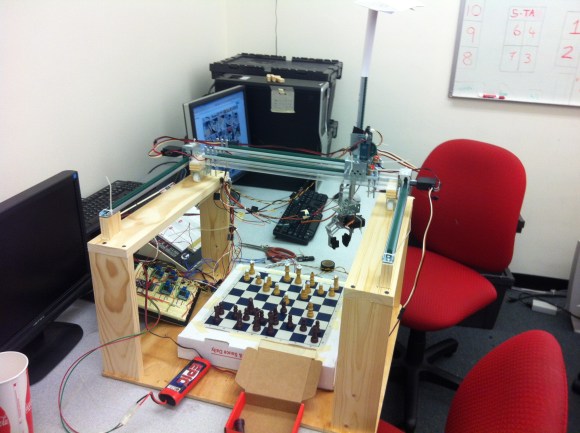
[Ben Yeh] wrote in to tell us about this voice-controlled chess robot he built along with three others as a final project for their Georgia Tech ECE 4180 Embedded Systems Design class.
To handle the speech recognition they grabbed an EasyVR board. This is a fine solution because it prevents the need for a computer to process voice commands (remember, it’s an embedded systems class). This concept breaks down when you find out that the desktop computer next to the robot is where the chess game is running. Perhaps that can be moved to a microcontroller by the next set of 4180 students.
The robot arm portion of the project is shown off well in the clip after the break. Normally we’d expect to see stepper motors driving the axes of a CNC machine but in this case they’re using servo motors with built-in encoders. The encoders are i2c devices which feed info back to the main controller. There was a parts ordering snafu and the z axis motor doesn’t have an encoder. No problem, they just added a distance sensor and a reflector to measure the up and down movement of the claw.















“Knight to E 5”
HP reference? I hope so, because that was the original inspiration for the project.
You should make it only respond to voice commands in a British accent.
The voice recognition chip used actually had severe problems with accents. We switched to the phonetic alphabet shortly after realizing this.
It needs a speech module so it can both confirm your move before making it, and make snide remarks about the inferiority of humans.
Actually, EasyVR does have some speech synthesis capabilities it seems. Having it insult the players couldn’t be *too* hard
We joked about adding a sound bite or speech synthesis as you said. We only got so far as actually removing pieces from the board into the white cardboard box as seen in the video
Taking chess to a whole new level of laziness. All hail thee.
This is awesome … Love it …
That’s a lot of students!
HOW DID the stepper motor remember each pieces? or identify each pieces
The location and identity of the pieces was ‘remembered’ by the chess program running on the desktop.